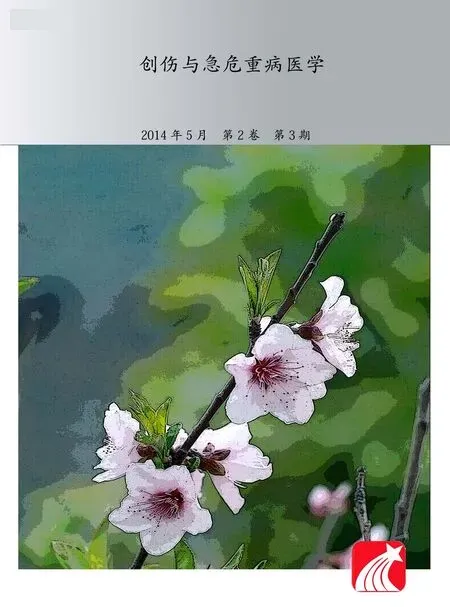腰椎后路单节段融合单侧置钉与双侧置钉远期相邻节段退变对比分析
谢雁春,陈 语,项良碧,刘 军
沈阳军区总医院骨科全军重症战创伤救治中心,辽宁 沈阳 110016
脊柱融合术是治疗脊柱退行性疾病及脊柱畸形的标准术式[1],术中置入内置物能够提供早期稳定性,为脊柱融合创造条件[2-5]。脊柱后路内置物中脊柱椎弓根螺钉成为目前能提供早期脊柱稳定性的最佳选择,然而术后固定融合节段相邻节段的退变成为目前脊柱外科医师关注的焦点[6,7]。
单侧置钉由于创伤较小,广泛应用于多种脊柱融合术中[8-11],而且就单节段融合而言,单侧置钉与双侧置钉在术后融合率、临床满意度、并发症发生率等方面与双侧置钉差异无统计学意义[9-11],而且单侧置钉手术时间与医疗费用都明显小于双侧置钉[9,10]。
脊柱融合内固定术中,相邻节段关节突关节在显露或置钉时经常被破坏[12-14],尤其是融合节段头侧的相邻节段,所以头侧相邻节段退变发生率要高于尾侧,有学者认为置钉时破坏头侧关节突关节是头侧相邻节段退变发生的主要原因之一[13,15]。因此,单侧置钉可有效避免破坏双侧头侧相邻节段关节突关节。目前报道单侧置钉与双侧置钉相邻节段退变发生率情况的文献较少。Suk等[9]曾在2000年报道87例病例中单侧置钉与双侧置钉相邻节段退变的比较。本研究主要通过远期随访研究单节段融合单侧置钉与双侧置钉相邻节段退变的差异。现报告如下。
1 资料与方法
1.1 纳入标准与排除标准 纳入标准为:(1)第一诊断均为腰椎管狭窄症与Ⅰ度腰椎滑脱症;(2)均行单节段椎间融合、行单侧或双侧置钉;(3)所有患者术前行MRI检查除外病变节段以外椎间盘退变[16-18]。排除标准为:(1)Ⅱ度以上(包括Ⅱ度)的腰椎滑脱;(2)既往曾行腰椎手术;(3)随访期间出现内固定物破坏。
1.2 临床资料 本组197例患者,其中男101例,女96例,年龄31~76岁,平均年龄47岁。其中147例接受影像学及临床症状随访,所有接受随访患者均行腰椎正侧位、动力位平片检查和功能障碍指数(ODI)评分。
1.3 手术前后腰椎弧度改变的测量 手术前后均行腰椎侧位片测量融合节段及腰椎的前凸角,融合节段的前凸角为上位椎体下终板延长线与下位椎体上终板延长线的夹角,腰椎前凸角为T12椎体下终板延长线与S1椎体上终板延长线的夹角,腰椎侧弯则采用Cobb角测量方法。
1.4 相邻节段退变相关参数的测量 相邻节段间盘退变分级评估早期主要根据加州大学洛杉矶分校分级标准[20],即在最后一次随访测量相邻节段成角变化和位移变化[21]。
1.5 相邻节段退变的影像学定义 相邻节段的影像学定位为腰椎屈伸动力为片相邻节段成角变化>10°,相对位移超过4 mm,或加州大学洛杉矶分校分级超过2级[17,19,22,23]。以前文献报道,相邻节段退变不仅累及头侧主要相邻节段,还可以累及头侧次要相邻节段[24,25]。因此,影像学评估相邻节段退变需评估头侧主要相邻节段、头侧次要相邻节段、尾侧相邻节段。
1.6 相邻节段退变的临床症状评估 术后末次随访均进行功能障碍指数(ODI)评分,相邻节段退变的临床症状主要根据相邻节段的不稳、神经根症状和需要翻修手术的相邻节段椎管狭窄,两组中出现相邻节段退变的患者需进行功能障碍指数(ODI)评分比较。
1.7 统计学分析 采用SPSS 13.0统计软件,两组患者的影像学指标、功能障碍指数均采用配对设计定量资料t试验,P<0.05为差异有统计学意义。
2 结 果
2.1 两组病理基本情况 本组197例中,79例行单侧椎弓根置钉(40.7%),115例行双侧椎弓根置钉(59.3%)。147例接受5年以上影像学和临床随访,其中单侧椎弓根置钉79例,双侧椎弓根置钉88例,两组间患者的年龄、性别、随访时间、融合节段、体质指数、术前诊断、融合节段比较,差异均无统计学意义。
2.2 术后腰椎曲度改变 两组患者术后腰椎曲度变化差异无统计学意义。见表1。

表1 单侧置钉组与双侧置钉组患者术后腰椎曲度变化±s)
2.3 两组患者术后相邻节段退变发生率比较 单侧置钉术后相邻节段(头侧或尾侧相邻节段)退变发生率为55.9%,双侧置钉相邻节段(头侧或尾侧相邻节段)退变发生率为72.7%,二组间差异有统计学意义。见表2。

表2 单侧置钉组与双侧置钉组术后相邻节段退变发生率比较±s)
注:本表格头侧相邻节段均为主要相邻节段。
然而,两组间头侧相邻节段退变及尾侧相邻节段退变比较,差异均无统计学意义(P=0.127,0.394)。本实验将头侧相邻节段分为主要相邻节段和次要相邻节段。结果显示,两组间头侧次要相邻节段退变差异有统计学意义(P=0.04)。见表3。

表3 头侧主要相邻节段与次要相邻节段退变发生率比较±s)
2.4 两组患者术后临床症状改善情况 最后一次随访单侧置钉组ODI为(22.2±11.6)分,双侧置钉组为(27.1±12.2)分,两组间ODI差异有统计学意义(P=0.016)。在不合并相邻节段退变的情况下,两组间功能障碍指数评分差异无统计学意义(P=0.127)。在合并相邻节段退变的情况下,两组间功能障碍指数评分差异有统计学意义(P=0.045)。见表4。

表4 术后两组患者功能障碍指数评分±s)
3 讨 论
3.1 内置物与相邻节段退变的关系 本研究认为,腰椎管狭窄症或腰椎间盘突出症行椎间融合单侧置钉相邻节段退变发生率较双侧置钉低,且根据功能障碍指数评定的临床效果,合并相邻节段退变的情况下,单侧置钉组要优于双侧置钉组。通常认为内置物是导致相邻节段退变的主要危险因素,但是文献报道无内置物的椎间融合也可发生相邻节段退变[24,26,27],而有内置物的椎间融合术后平均25个月出现影像学不稳[13],术后平均26.8个月出现相邻节段退变的临床症状[28]。由于内置物椎间融合导致相邻节段退变的根本原因尚不清楚,有学者提出两种假说:第一种假说椎弓根螺钉能够提供脊柱三柱的刚性,因此,椎弓根螺钉增加了融合节段的刚性,这个假说也与椎间融合联合椎弓根螺钉发生相邻节段退变的发生率增高的理论一致[13];第二种假说是基于前面的研究,非破坏性机械试验证实椎间融合器具有更好的刚性,因此,椎间融合器同时增加了融合节段的刚性[29-31]。但是这种假说与另一种绵羊模型的生物力学试验结论相悖,绵羊模型试验认为,牢固的后外侧融合的稳定性要大于内置物本身,而且一旦达到椎间融合,有内置物与无内置物的稳定性无差别。尽管内置物(包括椎弓根螺钉和椎间融合器)的材质和机械性能存在一定差别[30,31],而且引起相邻节段退变的融合节段刚性存在差别,但是内置物之间差别并不能完全且直接地反映融合节段刚性的差别,内置物材质和机械性能的差别仅能反映一部分融合节段刚性的差别[33]。因此,仔细评估放置内置物节段椎体局部骨质的减少[34]、椎间融合容积及矿物质密度的改变对远期的研究是非常重要的[35,36]。总之,影响椎间融合刚性的因素很多,也很难评估哪种因素对椎间融合刚性的影响最大。在一项对1 069例患者的回顾性研究中,发现只有术前的融合节段相邻节段的关节突关节的破坏是导致术后发生相邻节段退变的重要危险因素[15]。术中显露和置钉难免破坏和干扰融合节段相邻节段的关节突关节,因此,术中对相邻节段头侧的关节突关节的破坏被认为是导致远期相邻节段退变的主要因素之一。
3.2 融合节段头侧关节突关节破坏与相邻节段退变的关系 单侧置钉相邻节段退变发生率要明显小于双侧置钉,原因之一即为单侧置钉避免显露及置钉过程中对双侧相邻节段关节突关节的破坏。尽管目前研究显示,单侧置钉与双侧置钉融合节段头侧主要相邻节段的退变发生率差异无统计学意义(P=0.127),单侧头侧次要相邻节段的发生率单侧置钉要明显低于双侧置钉(P=0.04),行内置物与椎间融合后,头侧主要相邻节段的运动会受到一定限制,这会导致头侧次要相邻节段所承受的运动压力增加[25]。假设10年的随访后单侧置钉避免损伤双侧关节突关节的优点被术后其他与相邻节段退变有关的因素抵消,但是更长时间的随访,头侧次要相邻节段的优势一直存在。
本研究的主要不足之处是研究方法为回顾性研究,因为还有很多术后不能评估、不能定量、不能控制的因素影响相邻节段退变;其次,笔者认为,头侧主要及次要相邻节段退变的主要原因之一是术中对关节突关节的破坏而造成远期关节突关节的退变,但是并没有通过MRI检查证实关节突关节的退变;第三,由于相邻节段退变的定义并不统一,因此影像学与临床症状的结果并不是很统一;最后,没有通过影像学检查评估融合节段的融合质量。
尽管本研究存在很多不足之处,但是研究发现,影响相邻节段退变的危险因素,即关节突关节的损伤[6,7,15,19,37]。其次,本研究有严格的纳入标准与排除标准,排除了术前MRI检查提示存在相邻节段关节突关节退变的患者,排除了Ⅱ度滑脱的患者,主要原因为滑脱的患者生理弧度的改变会影响相邻节段退变的分析;最后,本结果为长期随访的研究。
通过5年以上的随访发现,单侧椎弓根置钉的腰椎融合术影像学相邻节段尤其是头侧次级相邻节段退变的发生率较低,且由此引起的临床症状也较双侧椎弓根置钉组较轻。
[1] Malmivaara A,Slötis P,Heliövaara M,et al.Surgical or nonoperative treatment for lumbar spinal stenosis? A randomized controlled trial[J].Spine,2007,32(1):1-8.
[2] Ghogawala Z,Benzel EC,Amin-Hanjani S.Prospective outcomes evaluation after decompression with or without instrumented fusion for lumbar stenosis and degenerative Grade I spondylolisthesis[J].J Neurosurg Spine,2004,1(3):267-272.
[3] Zdeblick TA.A prospective,randomized study of lumbar fusion.Preliminary results[J].Spine,1993,18(8):983-991.
[4] Fischgrund JS,Mackay M,Herkowitz HN.1997 Volvo Award winner in clinical studies.Degenerative lumbar spondylolisthesis with spinal stenosis: a prospective,randomized study comparing decompressive laminectomy and arthrodesis with and without spinal instrumentation[J].Spine,1997,22(24):2807-2812.
[5] Kornblum MB,Fischgrund JS,Herkowitz HN.Degenerative lumbar spondylolisthesis with spinal stenosis: a prospective long-term study comparing fusion and pseudarthrosis[J].Spine,2004,29(7):726-733;discussion 733-734.
[6] Park P,Garton HJ,Gala VC,et al.Adjacent segment disease after lumbar or lumbosacral fusion: review of the literature[J].Spine,2004,29(17):1938-1944.
[7] Shono Y,Kaneda K,Abumi K,et al.Stability of posterior spinal instrumentation and its effects on adjacent motion segments in the lumbosacral spine[J].Spine,1998,23(14):1550-1558.
[8] Aoki Y,Yamagata M,Ikeda Y.A prospective randomized controlled study comparing transforaminal lumbar interbody fusion techniques for degenerative spondylolisthesis: unilateral pedicle screw and 1 cage versus bilateral pedicle screws and 2 cages[J].J Neurosurg Spine,2012,17(2):153-159.
[9] Suk KS,Lee HM,Kim NH,et al.Unilateral versus bilateral pedicle screw fixation in lumbar spinal fusion[J].Spine,2000,25(14):1843-1847.
[10] Fernández-Fairen M,Sala P,Ramírez H,et al.A prospective randomized study of unilateral versus bilateral instrumented posterolateral lumbar fusion in degenerative spondylolisthesis[J].Spine,200,32(4):395-401.
[11] Kabins MB1,Weinstein JN,Spratt KF.Isolated L4-L5 fusions using the variable screw placement system: unilateral versus bilateral[J].J Spinal Disord,1992,5(1):39-49.
[12] Shah RR,Mohammed S,Saifuddin A.Radiologic evaluation of adjacent superior segment facet joint violation following transpedicular instrumentation of the lumbar spine[J].Spine,2003,28(3):272-275.
[13] Zencica P,Chaloupka R,Hladíková J,et al.Adjacent segment degeneration after lumbosacral fusion in spondylolisthesis: a retrospective radiological and clinical analysis[J].Acta Chir Orthop Traumatol Cech,2010,77(2):124-130.
[14] Wiltse LL,Radecki SE,Biel HM.Comparative study of the incidence and severity of degenerative change in the transition zones after instrumented versus noninstrumented fusions of the lumbar spine[J].J Spinal Disord,1999,12(1):27-33.
[15] Lee JC,Kim Y,Soh JW,et al.Risk factors of adjacent segment disease requiring surgery after lumbar spinal fusion: comparison of posterior lumbar interbody fusion and posterolateral fusion[J].Spine,2014,39(5):E339-345.
[16] Pfirrmann CW,Metzdorf A,Zanetti M,et al.Magnetic resonance classification of lumbar intervertebral disc degeneration[J].Spine,2001,26(17):1873-1878.
[17] Kim KH,Lee SH,Shim CS,et al.Adjacent segment disease after interbody fusion and pedicle screw fixations for isolated L4-L5 spondylolisthesis: a minimum five-year follow-up[J].Spine,2010,35(6):625-634.
[18] Weishaupt D,Zanetti M,Boos N,et al.MR imaging and CT in osteoarthritis of the lumbar facet joints[J].Skeletal Radiol,1999,28(4):215-219.
[19] Cheh G,Bridwell KH,Lenke LG,et al.Adjacent segment disease following lumbar/thoracolumbar fusion with pedicle screw instrumentation: a minimum 5-year follow-up[J].Spine,2007,32(20):2253-2257.
[20] Ghiselli G,Wang JC,Hsu WK,et al.L5-S1 segment survivorship and clinical outcome analysis after L4-L5 isolated fusion[J].Spine,2003,8(12):1275-1280;discussion 1280.
[21] Dupuis PR,Yong-Hing K,Cassidy JD,et al.Radiologic diagnosis of degenerative lumbar spinal instability[J].Spine,1985,10(3):262-276.
[22] Min JH,Jang JS,Lee SH.Comparison of anterior- and posteriorapproach instrumented lumbar interbody fusion for spondylolisthesis[J].J Neurosurg Spine,2007,7(1):21-26.
[23] Ghiselli G,Wang JC,Bhatia NN,et al.Adjacent segment degeneration in the lumbar spine[J].J Bone Joint Surg Am,2004,86-A(7):1497-1503.
[24] Schlegel JD,Smith JA,Schleusener RL.Lumbar motion segment pathology adjacent to thoracolumbar,lumbar,and lumbosacral fusions[J].Spine,1996,21(8):970-981.
[25] Chou WY,Hsu CJ,Chang WN,et al.Adjacent segment degeneration after lumbar spinal posterolateral fusion with instrumentation eration after lumbar spinal posterolateral fusion with instrumentation in elderly patients[J].Arch Orthop Trauma Surg,2002,122(1):39-43.
[26] Lee CK.Accelerated degeneration of the segment adjacent to a lumbar fusion[J].Spine,1988,13(3):375-377.
[27] Whitecloud TS,Davis JM,Olive PM.Operative treatment of the degenerated segment adjacent to a lumbar fusion[J].Spine,1994,19(5):531-536.
[28] Etebar S,Cahill DW.Risk factors for adjacent-segment failure following lumbar ?xation with rigid instrumentation for degenerative instability[J].J Neurosurg,1999,90 (2 Suppl):163-169.
[29] Boden SD,Sumner DR.Biologic factors affecting spinal fusion and bone regeneration[J].Spine,1995,20 (24 Suppl):S102-S112.
[30] Kleiner JB,Odom JA Jr,Moore MR,et al.The effect of instrumentation on human spinal fusion mass[J].Spine,1995,20(1):90-97.
[31] McAfee PC,Farey ID,Sutterlin CE,et al.The effect of spinal implant rigidity on vertebral bone density.A canine model[J].Spine,1991,16(6 Suppl):S190-197.
[32] Kanayama M,Cunningham BW,Weis JC,et al.The effects of rigid posterolateral spinal arthrodesis model[J].Spine,1998,23(7):767-773.
[33] Stanford RE,Loefler AH,Stanford PM,et al.Multiaxial pedicle screw designs: static and dynamic mechanical testing[J].Spine,2004,29(4):367-375.
[34] Myers MA,Casciani T,Whitbeck MG Jr,et al.Vertebral body osteopenia associated with posterolateral spine fusion in humans[J].Spine,1996,21(20):2368-2371.
[35] Kim KW,Ha KY,Moon MS,et al.Volumetric change of the graft bone after intertransverse fusion[J].Spine,1999,24(5):428-433.
[36] Lee JS,Kim KW.Bone mineral densities of the vertebral body and intertransverse fusion mass after instrumented intertransverse process fusion[J].Spine,2010,35(21):E1106-E1110.
[37] Anandjiwala J,Seo JY,Ha KY,et al.Adjacent segment degeneration after instrumented posterolateral lumbar fusion: a prospective cohort study with a minimum five-year follow-up[J].Eur Spine J,2011,20(11):1951-1960.

